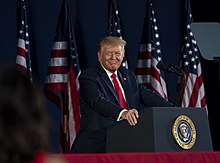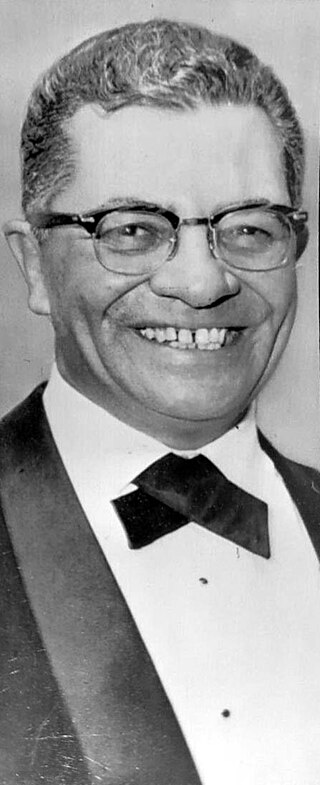
Vincent Thomas Lombardi was an American football coach and executive in the National Football League (NFL). Lombardi is considered by many to be the greatest coach in American football history, and he is recognized as one of the greatest coaches and leaders in the history of all American sports. He is best known as the head coach of the Green Bay Packers during the 1960s, where he led the team to three straight and five total NFL Championships in seven years, in addition to winning the first two Super Bowls at the conclusion of the 1966 and 1967 NFL seasons.

In the United States, an executive order is a directive by the president of the United States that manages operations of the federal government. The legal or constitutional basis for executive orders has multiple sources. Article Two of the United States Constitution gives presidents broad executive and enforcement authority to use their discretion to determine how to enforce the law or to otherwise manage the resources and staff of the executive branch. The ability to make such orders is also based on expressed or implied Acts of Congress that delegate to the president some degree of discretionary power. The vast majority of executive orders are proposed by federal agencies before being issued by the president.

The Albert Memorial, directly north of the Royal Albert Hall in Kensington Gardens, London, was commissioned by Queen Victoria in memory of her beloved husband Prince Albert, who died in 1861. Designed by Sir George Gilbert Scott in the Gothic Revival style, it takes the form of an ornate canopy or pavilion 176 feet (54 m) tall, in the style of a Gothic ciborium over the high altar of a church, sheltering a statue of the prince facing south. It took over ten years to complete, the £120,000 cost met by public subscription.
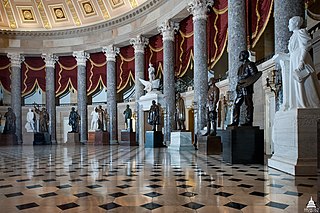
The National Statuary Hall is a chamber in the United States Capitol devoted to sculptures of prominent Americans. The hall, also known as the Old Hall of the House, is a large, two-story, semicircular room with a second story gallery along the curved perimeter. It is located immediately south of the Rotunda. The meeting place of the U.S. House of Representatives for nearly 50 years (1807–1857), after a few years of disuse in 1864 it was repurposed as a statuary hall; this is when the National Statuary Hall Collection was established. By 1933, the collection had outgrown this single room, and a number of statues are placed elsewhere within the Capitol.

The Virginia State Capitol is the seat of state government of the Commonwealth of Virginia, located in Richmond, the state capital. It houses the oldest elected legislative body in North America, the Virginia General Assembly, first established as the House of Burgesses in 1619.

John Quincy Adams Ward was an American sculptor, whose most familiar work is his larger than life-size standing statue of George Washington on the steps of Federal Hall National Memorial in New York City.
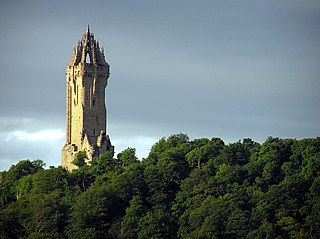
The National Wallace Monument is a 67 metres (220 ft) tower on the shoulder of the Abbey Craig, a hilltop overlooking Stirling in Scotland. It commemorates Sir William Wallace, a 13th- and 14th-century Scottish hero.
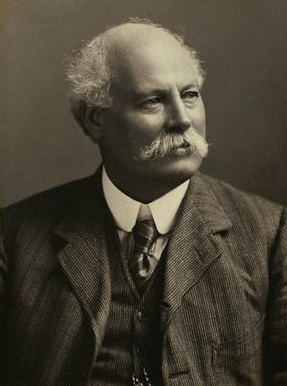
Sir Thomas Brock was an English sculptor and medallist, notable for the creation of several large public sculptures and monuments in Britain and abroad in the late nineteenth and early twentieth centuries. His most famous work is the Victoria Memorial in front of Buckingham Palace, London. Other commissions included the redesign of the effigy of Queen Victoria on British coinage, the massive bronze equestrian statue of Edward, the Black Prince, in City Square, Leeds and the completion of the statue of Prince Albert on the Albert Memorial.

Sir William Goscombe John was a prolific Welsh sculptor known for his many public memorials. As a sculptor, John developed a distinctive style of his own while respecting classical traditions and forms of sculpture. He gained national attention with statues of eminent Victorians in London and Cardiff and subsequently, after both the Second Boer War and World War I, created a large number of war memorials. These included the two large group works, The Response 1914 in Newcastle upon Tyne and the Port Sunlight War Memorial which are considered the finest sculptural ensembles on any British monument.

Frederick William Pomeroy was a prolific British sculptor of architectural and monumental works. He became a leading sculptor in the New Sculpture movement, a group distinguished by a stylistic turn towards naturalism and for their works of architectural sculpture. Pomeroy had several significant public works in London and elsewhere in the United Kingdom, notably in Belfast. His work in London includes the figure of Lady Justice (1905–1906) on the dome of the Old Bailey.
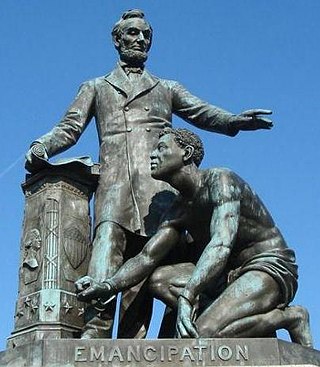
The Emancipation Memorial, also known as the Freedman's Memorial or the Emancipation Group is a monument in Lincoln Park in the Capitol Hill neighborhood of Washington, D.C. It was sometimes referred to as the "Lincoln Memorial" before the more prominent so-named memorial was dedicated in 1922.
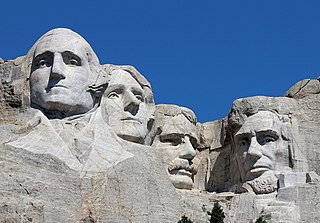
Because of its fame as a monument, Mount Rushmore in South Dakota has appeared frequently in works of fiction. It has been discussed or depicted in dozens of popular works, such as the location of the climactic chase scene in Alfred Hitchcock's 1959 film North by Northwest, and in the 2007 film National Treasure: Book of Secrets. Repeated themes using the mountain have been depictions of its destruction to imply a larger catastrophe, alterations or additions being made to the famous faces on the mountain, or use of the monument as a cover to hide a secret such as a treasure trove or military base.

Lafayette Square is a seven-acre public park located within President's Park in Washington, D.C., directly north of the White House on H Street, bounded by Jackson Place on the west, Madison Place on the east and Pennsylvania Avenue on the south. It is named for the Marquis de Lafayette, a French aristocrat and hero of the American Revolutionary War (1775–1783) and includes several statues of revolutionary heroes from Europe, including Lafayette, and at its center a famous statue of early 19th century U.S. president and general Andrew Jackson on horseback with both of the horse's front hooves raised.

The Civil War Monuments in Washington, D.C. are a group of seventeen outdoor statues which are spread out through much of central and northwest Washington, D.C. The statues depict 11 Union generals and formerly included one Confederate general, Albert Pike, who was depicted as a Mason and not as a general. The Pike statue was torn down on Juneteenth 2020, as part of the George Floyd protests. Two Union admirals are honored, although Admiral Samuel Francis DuPont's statue was removed to Wilmington, Delaware, and he is now honored with a fountain. Other statues depict nuns, peace, emancipation, and the Grand Army of the Republic.

A number of statues and memorials have been the subject of protests and petitions during the George Floyd protests in the United Kingdom in 2020.

A statue of Christopher Columbus was installed in Denver, Colorado, United States. It was the work of Denver-based artist William F. Joseph, dedicated in 1972. Joseph's statue was vandalized and torn down by protestors in June 2020 during the civil unrest that followed the murder of George Floyd in May 2020. A number of monuments and memorials across the United States associated with racial injustice were vandalized, destroyed or removed. The statue is being stored at an undisclosed location.

In June 2020, the Trump administration began deploying federal law enforcement forces to select cities in the United States in response to rioting and monument removals amid the George Floyd protests. Federal law enforcement elements were deployed under Operation Legend, Operation Diligent Valor, and the Protecting American Communities Task Force (PACT). The Department of Homeland Security (DHS) cited an executive order regarding "monuments, memorials and statues" as allowing federal officers to be deployed without the permission of individual U.S. states, as the federal government "has the right to enforce federal laws, investigate crimes and make arrests" within states.

The 1776 Commission, also nicknamed the 1776 Project, was an advisory committee established in September 2020 by then-U.S. President Donald Trump to support what he called "patriotic education". The commission released The 1776 Report on January 18, 2021, two days before the end of Trump's term. Historians overwhelmingly criticized the report, saying it was "filled with errors and partisan politics". The commission was terminated by the successive President Joe Biden on January 20, 2021, his first day in office.
